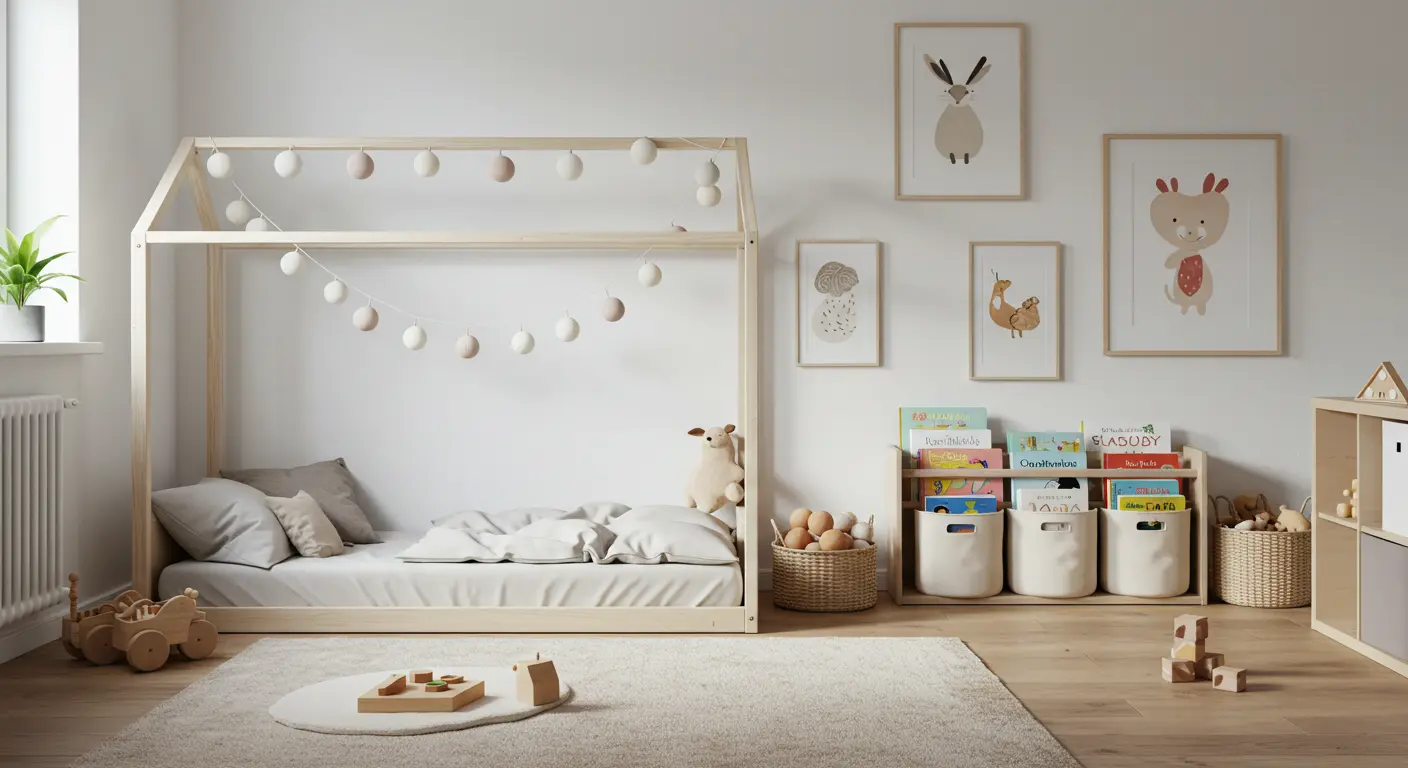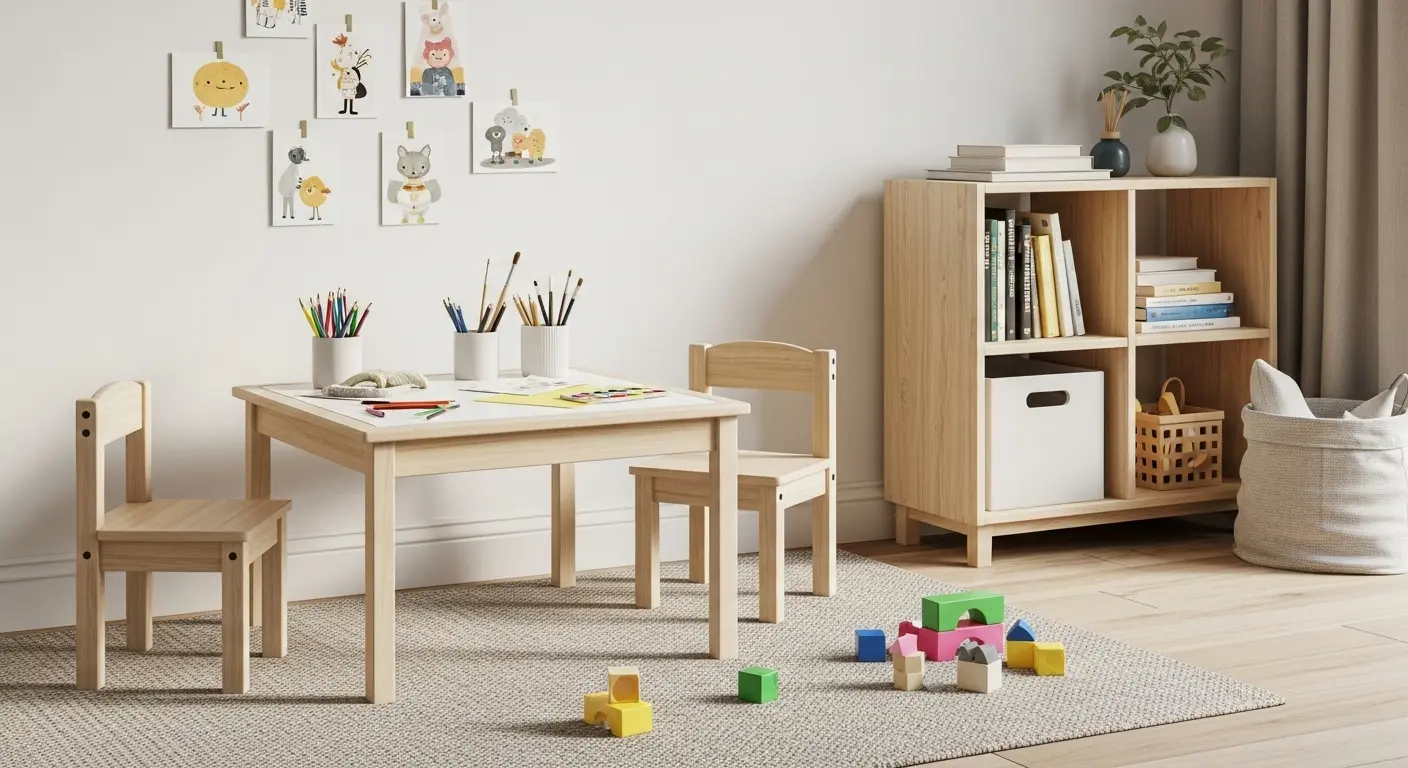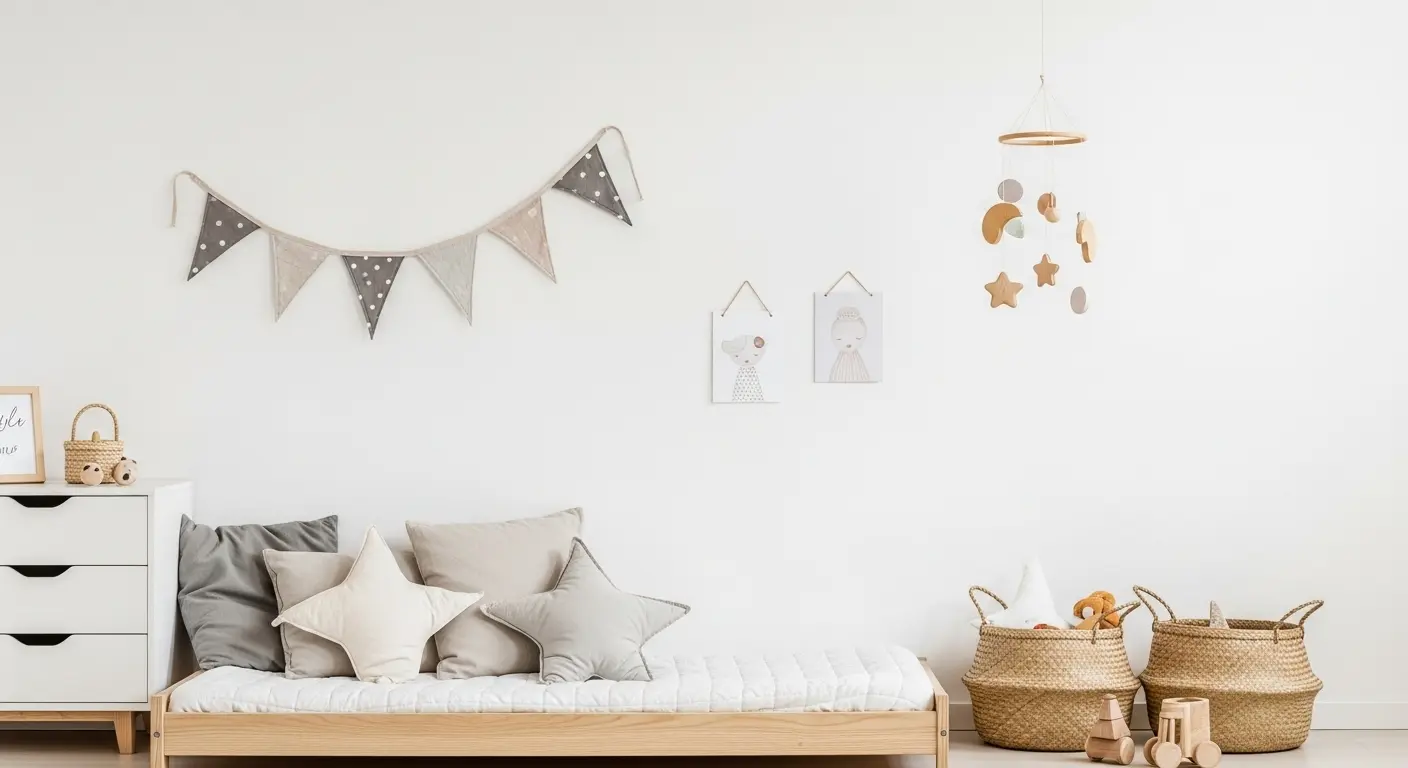
Creating a minimalist children’s room goes far beyond keeping everything organized — it’s about providing an environment that stimulates creativity, autonomy, and the child’s development. With intelligent furniture choices, functional organization, and light decor, you can transform even the smallest spaces into settings that encourage free play, learning, and well-being.
In this article, you’ll discover practical tips and minimalist solutions to keep the room organized, beautiful, and, above all, full of possibilities for the little ones’ imagination.
Why Minimalism Stimulates Children’s Creativity
When we think of a minimalist children’s room, we’re not just talking about aesthetics, but about creating an environment that promotes the child’s healthy development. A space with fewer excesses offers more freedom to play, imagine, and create, becoming a true invitation for children’s creativity to flourish.
Less Stimuli, More Focus
Visually cluttered environments can lead to sensory overload in children, making it difficult to concentrate and even increasing anxiety. On the other hand, an organized room, with a neutral color palette and few visible objects, allows children to direct their attention to what really matters: exploring, creating stories, and engaging more deeply with play.
The Importance of Free Space
Free space is, in fact, the greatest ally of children’s imagination. Without the interference of excessive furniture or cluttered shelves, the child gains freedom of movement and more possibilities to create their own worlds. It is in this purposeful emptiness that improvised forts, car tracks on the floor, pretend play scenarios, and games that don’t depend on many objects, but only on creativity, emerge.
How Excess Can Lead to Distraction and Anxiety
Accumulated toys, overly vibrant colors, and excessive visual information can lead to constant distraction. The child doesn’t know where to start, quickly loses interest, and finds it difficult to concentrate on a single activity. Minimalism, in this context, offers a practical and effective solution: fewer things, more quality experiences.
Minimalist Organization: How to Keep Everything in Place
Maintaining an organized minimalist children’s room doesn’t mean giving up fun, but rather creating a space where everything has its function and its place. Organization is one of the foundations of minimalism, and when applied to the children’s environment, it brings more autonomy, practicality, and well-being to the whole family.

Basic Principles of Organization in the Children’s Room
The first step is to apply the basic principles of minimalism: reduce excess, define what is truly essential, and create simple and visual organization systems. Having fewer objects not only facilitates organization but also the conscious use of toys and materials.
When the space is free of clutter, the child finds it easier to concentrate on activities and naturally learns to value what they have. Furthermore, an organized environment creates a sense of calm and well-being, both for children and adults.
Categorization and Visual Storage Techniques
Organizing by categories is a powerful strategy. Separate toys into groups such as blocks, books, dolls, art supplies, or games. Use baskets, boxes, and low shelves, which keep everything visible and accessible, facilitating not only organization but also encouraging autonomy.
Visual labels also make all the difference, especially for children who cannot yet read. Photos, drawings, or symbols indicate where each item should be stored, making the process of putting away toys simpler, more intuitive, and even fun.
Practical Solutions: Shelves, Baskets, and Niches
The secret to an organized children’s room lies in the use of functional furniture and versatile organizers. Low shelves help with the arrangement of books and objects that the child uses frequently. Open niches and natural fiber or cotton baskets are perfect for toys, creative materials, and everyday items.
In addition to bringing visual lightness, these organizers keep the environment practical and beautiful, aligned with the aesthetic of minimalist children’s decor.
Toy Rotation: Less, But Always New
The toy rotation technique is an indispensable ally in the concept of minimalist organization. Instead of making all toys available at once, choose a small selection and store the rest in boxes out of reach.
Every week or fortnight, make a swap: remove some items and put others in their place. This not only maintains the child’s interest but also prevents accumulation, reduces clutter, and stimulates creativity, as the child begins to explore each available item more deeply.
To delve deeper into toy organization, also see our article on how to reduce the number of toys without losing the fun.
Stimulating Creativity in Simple Environments
One of the great benefits of a minimalist children’s room is precisely how much it stimulates the child’s creativity. By eliminating excesses and focusing on the essential, you open up space — physical and mental — for little ones to imagine, create, and explore without limits.
How Free Space Encourages Inventive Play
Free space is not just the absence of furniture or objects; it is an open invitation to imagination. Without obstacles in the way, the child gains freedom to create scenarios, build forts, draw on the floor, or invent stories. This stimulates what is known as symbolic play, fundamental for cognitive and emotional development.
Playing with less also promotes problem-solving, autonomy, and creative thinking, as the child learns to do more with less.
Creating Functional Zones: Play, Read, Create, and Rest
Even in small rooms, it is possible (and recommended) to divide the space into functional zones, each dedicated to an activity. A reading nook with cushions and accessible books, a free area on the floor for symbolic play, a low table for manual activities, and, of course, the resting space.
This simple organization helps the child understand that each space has a purpose, promoting the development of concentration and autonomy.
Materials that Stimulate Creativity: Less Plastic, More Nature
Opting for toys and materials made from natural elements, such as wood, fabric, bamboo, or cardboard, stimulates creativity more than electronic or plastic toys that do everything on their own. Open-ended materials — such as building blocks, interlocking pieces, cloths, boxes, and everyday objects — promote exploration and the use of imagination.
These elements not only combine with the aesthetic of the minimalist children’s room but are also more sustainable, durable, and educational.
If you’re looking for toy suggestions that stimulate imagination and take up little space, check out our selection of minimalist toys that make a difference in child development.

Incorporating Sensory Elements: Textures, Light, and Sounds
Even a simple environment can (and should) be rich in sensory stimuli, in a balanced way. Invest in natural textures, such as cotton rugs, wicker baskets, linen cushions, and raw wood.
Soft lighting, whether natural or with indirect lights, contributes to a cozy and peaceful environment, while small elements like wind chimes, mobiles, or simple musical instruments offer pleasant sound stimuli that also fuel creativity.
Minimalist Decor with a Playful Touch
The decor of a minimalist children’s room doesn’t have to be boring; quite the opposite. It’s entirely possible to combine simplicity, functionality, and lightness with elements that bring joy, comfort, and stimulate the child’s imagination.
Neutral Color Palette with Pops of Color
The base of a minimalist environment is generally composed of neutral tones — such as white, beige, light gray, and natural wood. These tones help create a calm, organized environment free of visual clutter.
To add a playful touch, you can add strategic pops of color through cushions, pictures, rugs, or small decorative objects. The secret is balance: using color to highlight, without overwhelming.
How to Use Posters, Banners, and Pictures in a Balanced Way
Simple decorative elements can make all the difference. Posters with delicate illustrations, inspiring phrases, or maps are great options. Fabric banners, wooden or felt mobiles, and small pictures aligned at the child’s height help create a decor that is both fun and peaceful.
When choosing these items, prioritize natural, artisanal, or handmade materials, which bring more coziness and authenticity to the space.
Lighting that Promotes Concentration and Coziness
Lighting is one of the most important elements to reinforce both comfort and functionality in the room. Prefer indirect lights, such as lamps, wall sconces, and LED strips, always in warm tones, which create a sense of calm and coziness.
If possible, make the most of natural lighting, using light curtains that filter the light without completely blocking it. Well-thought-out lighting transforms the room into a space that invites both play and relaxation.
Choosing Furniture that Combines Aesthetics, Functionality, and Fun
In a minimalist children’s room, furniture plays a leading role. Prefer pieces with straight lines, simple design, and multi-functional. Beds with drawers, low shelves, tables that can be used for various activities, and benches that serve as storage chests are great examples.
In addition to contributing to organization, these furniture pieces also make the environment more adaptable, comfortable, and, above all, prepared to accompany the different phases of childhood.

How to Involve the Child in the Process
More than creating a minimalist children’s room, it is essential to make the child an active part of this process. When they participate in the organization, the choice of objects, and even the decor, they develop a sense of responsibility, autonomy, and a much greater connection with the space.
Making the Child the Protagonist in Organizing Their Own Room
Involving little ones in organization is an incredible learning opportunity. Allowing them to choose where to store toys, how to arrange books, and even helping to categorize objects makes them feel responsible and more engaged in maintaining the space.
Furthermore, when organization is designed from the child’s perspective — with accessible furniture, baskets at their height, and simple systems — daily life becomes lighter and more practical for everyone.
How to Teach Detachment in a Playful and Loving Way
Detachment can be approached in a fun and positive way. For example, create a “love box” where the child separates toys they no longer use to be donated to other children. Tell stories about how that toy can make another person happy.
This type of activity not only reduces the excess of objects in the minimalist children’s room but also helps develop empathy, generosity, and awareness about consumption.
Encouraging Conscious Choices from Childhood
When a child is involved in choices — whether selecting a new toy, choosing a cushion, or deciding where a piece of furniture will go — they learn early on to reflect before consuming.
Explain simply the difference between needing and wanting. This type of conversation forms the basis for more conscious thinking, aligned with minimalism as a lifestyle, which they can carry into other areas of life.
Transforming Organization into a Light and Fun Routine
Organizing doesn’t have to be a boring task. Create a light routine, with music, challenges, or even timers to make the process more playful. For example, you can propose a “quick tidy-up game” where you see who can put away more toys in less time, or create illustrated labels that help identify objects.
This way, organizing ceases to be an obligation and becomes part of the game, reinforcing the idea that an organized and functional space is natural and enjoyable.
Sustainability and Conscious Consumption in the Children’s Room
A minimalist children’s room goes far beyond aesthetics and organization. It also reflects values such as sustainability, conscious consumption, and respect for the environment. Teaching these principles early helps shape children who are more aware, responsible, and connected to the world.
Why Choose Natural and Non-Toxic Materials
Choosing natural and non-toxic materials makes all the difference in creating a healthier environment for the child and also a more sustainable one for the planet. Prefer furniture made of certified wood, cotton, linen, natural fibers, and low-VOC paints.
In addition to being more durable and safer options, these materials bring coziness, texture, and a greater connection with nature, reinforcing the proposal of the minimalist children’s room.
Advantages of Repurposing and DIY (Do It Yourself)
Giving new life to old furniture, repurposing boxes, baskets, or creating decorative objects with simple materials are practices that not only reduce environmental impact but also add personality to the space.
DIY projects — such as shelves made from reclaimed wood, fabric banners, or handmade mobiles — make the environment more affectionate, unique, and aligned with the concept of conscious consumption.
Less is More: How to Teach the Value of the Essential from an Early Age
Having fewer objects, but ones that truly make sense, is a valuable lesson that can begin within the child’s own room. Show the child that they don’t need many toys to have fun, that a well-chosen book or a creative game can provide hours of entertainment.
This learning encourages the development of a more attentive and conscious perspective, where experiences, bonds, and moments are valued more than things. The minimalist children’s room then becomes a true tool for cultivating this lifestyle from childhood.
Checklist: Essential Items for a Minimalist Children’s Room
| Item | Function | Minimalist Benefit |
|---|---|---|
| Organizer Baskets | Store toys and materials | Easy access, visually clean |
| Low Shelf | Store books and objects | Stimulates autonomy and organization |
| Activity Table | Space for drawing, creating, and learning | Fosters creativity and focus |
| Comfortable Rug | Free area for floor play | Creates a safe and cozy play zone |
| Soft and Indirect Lighting | Comfort and well-being | Calm environment conducive to concentration |
| Neutral Color Palette | Decor base | Reduces visual stimuli and creates tranquility |
Conclusion: Less is More When It Comes to Childhood
Creating a minimalist children’s room is much more than organizing objects or choosing beautiful decor. It is a conscious choice that promotes well-being, stimulates creativity, and teaches, from an early age, the value of the essential.
By focusing on fewer things, but more meaning, you transform the environment into a space where the child can grow, play, learn, and develop autonomy in a light and natural way. Simplicity does not limit — it opens doors to infinite possibilities of imagination, connection, and development.
If this content inspired you, continue exploring Minimals Vibe and discover how minimalism can transform not only spaces but also your family life.
